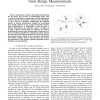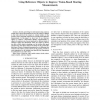119
click to vote
INFOCOM
2010
IEEE
14 years 11 months ago
2010
IEEE
—Knowing accurate positions of nodes in wireless ad-hoc and sensor networks is essential for a wide range of pervasive and mobile applications. However, errors are inevitable in ...
99
Voted
ICRA
2010
IEEE
14 years 11 months ago
2010
IEEE
Abstract— In this paper, we address the problem of determining the relative position and orientation (pose) of two robots navigating in 2D, based on known egomotion and noisy rob...
122
Voted
NETWORK
2007
15 years 16 days ago
2007
If we abstract a sensor network as a network graph consisting of vertices and edges, where vertices represent sensor nodes and edges represent distance measurements between neighbo...
86
Voted
TROB
2008
15 years 28 days ago
2008
In this paper, we address the problem of determining the 2D relative pose of pairs of communicating robots from (i) robot-to-robot distance measurements and (ii) displacement estim...
DCOSS
2006
Springer
15 years 4 months ago
2006
Springer
Abstract. We have developed a new on-line error modeling and optimizationbased localization approach for sensor networks in the presence of distance measurement noise. The approach...
LOCA
2005
Springer
15 years 6 months ago
2005
Springer
Abstract. We present an improvement to ultrasound–based indoor location systems like Cricket [1]. By encoding and modulating the ultrasound pulses, we are able to achieve greater...
113
Voted
SBACPAD
2005
IEEE
15 years 6 months ago
2005
IEEE
The time required to simulate a complete benchmark program using the cycle-accurate model of a microprocessor can be prohibitively high. One of the proposed methodologies, represe...
IROS
2007
IEEE
15 years 7 months ago
2007
IEEE
Abstract— In this paper, we develop an algorithm for determining the relative position and attitude of two robots moving in 3D, using only dead-reckoning and inter-robot distance...
104
click to vote
ICRA
2007
IEEE
15 years 7 months ago
2007
IEEE
Abstract— In this paper we address the problem of determining the relative pose of pairs robots that move on a plane while measuring the distance to each other. We show that the ...
IROS
2008
IEEE
15 years 7 months ago
2008
IEEE
— Robots perceiving its environment using cameras usually need a good representation of how the camera is aligned to the body and how the camera is rotated relative to the ground...






